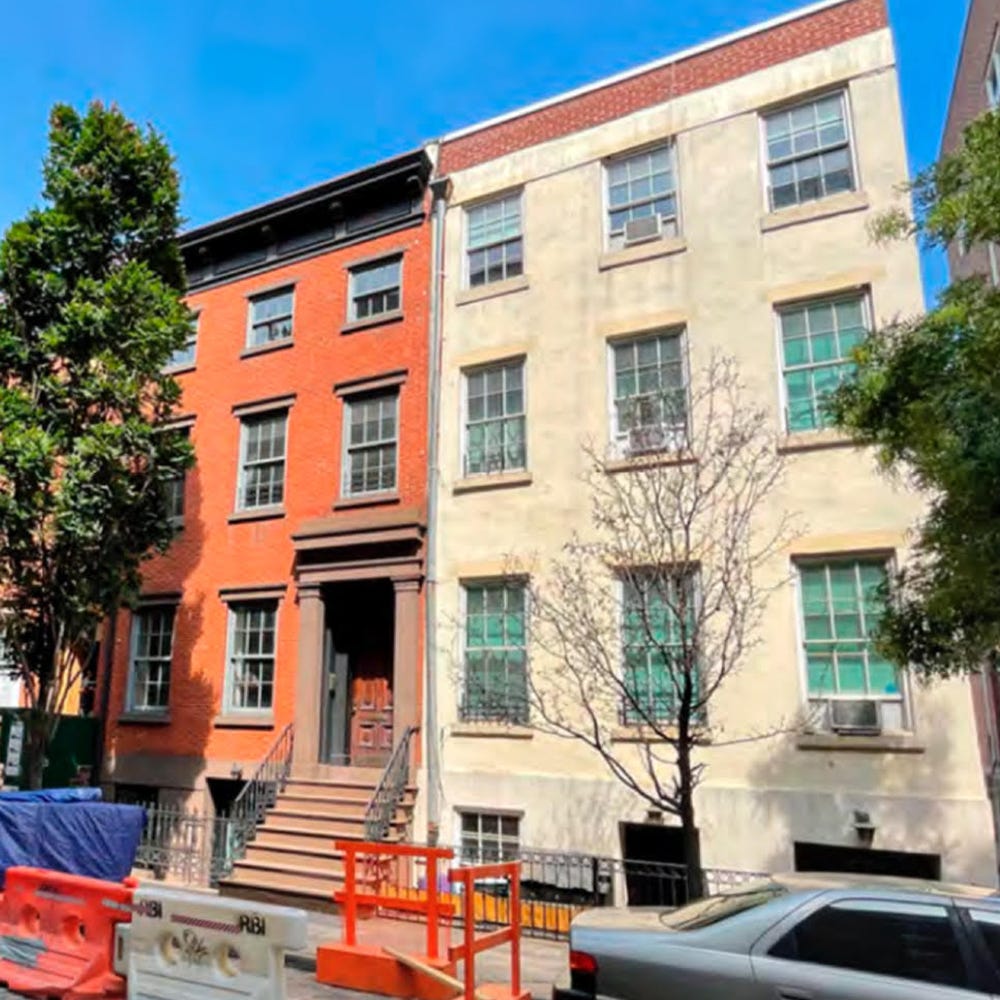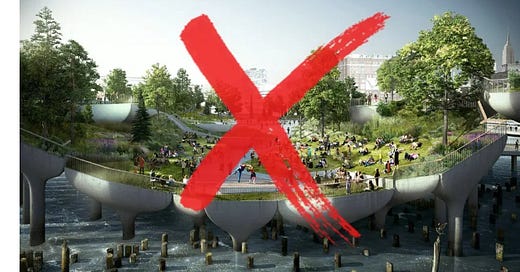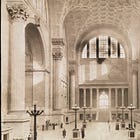This is Part 2 of a multi-part series on preservation. 🧑🎓🏛️
See here for Part 1 and Part 3:
While I don’t identify as a preservationist, I have a lot of respect for their game. They’re a small group of people with an outsize voice. And their issue isn’t sexy: the injustices are about terra cotta, not human rights…. limestone, not life vs. death.
So what are the moves that they use to build and keep power?
TBH, the following moves aren’t unique to preservation groups– they’re part of the standard local advocacy playbook. Here’s what it looks like to build power when you care about cornices and art deco:
Lawsuits
City Club of New York killed Little Island with a lawsuit. Until then-Governor Cuomo intervened.
In 2017, Barry Diller, the philanthropist financing Little Island, gave up. He’d been fighting City Club’s lawsuit for 2 years and, without an end in sight to the litigation, deemed the project too expensive to continue.
City Club’s lawsuit was based on 1) potential danger to a protected estuary and 2) that the project was not transparent to the public and would turn public parks into “playgrounds for the wealthy”.
Lawsuits are an incredibly effective strategy to hold up particular projects and increase their costs. In this (unusual) case, it took intervention from the governor to drop the suit and move forward with the project.
PR Stunts
The Municipal Art Society (MAS) collaborated to host a funeral procession for a lobby. In January, the group dressed in black and ”cocaine chic” attire, marched through the Financial District, and gave elegies to the atrium at 60 Wall Street.
The atrium’s post modern design invoked “80s cocaine decor”, but was not meaningful enough to be granted protection by the NYC Landmarks Preservation Commission. Since the building has been vacant since Deutsche Bank left the building in 2021, the owner is redoing the atrium in an effort to attract a new anchor tenant.
Stunts like this funeral procession are a way to get more press for your cause, and engage previously unaware / unconcerned citizens.

Coalition
In the months leading up to the 2021 mayoral primary, 14 preservationist groups collaborated on a petition to push mayoral candidates to add preservation to their mayoral platforms. The change.org petition received nearly 5,500 signatures.
Working in coalition, the groups were able to combine their people power to gather more signatures and show more power than any one group could have on its own.
Join (and run) your Community Board
Community boards have the opportunity to provide comments and recommendations to the Landmarks Preservation Commission on everything from individual projects to rule changes. It makes sense for people who care about preservation to join their community board to weigh in. My community board, Manhattan Community Board 5, recently had four City Club members on the board: three on our executive committee and one public member. The President of City Club even led CB5’s Landmarks and Land Use committees.
Othering
Some preservation groups create “us vs. them” dynamics by villainizing individuals, organizations, and agencies that have conflicting perspectives. Most often, villainizing comes in the form of questioning their motives– accusing them for having profit as a motivation.
For example, Village Preservation recently led a campaign against the city installing 5G towers in the West Village and other historic districts. Village Preservation claimed the “motivation for siting seems to be monetizing data collected by the towers or space on or within them, rather than actually bridging any digital divide.” The argument is that the city is putting profit ahead of people. Preservationists use this argument for development as well— accusing others of caring only about money.
Now it’s totally possible that the city had a subpar process for siting 5G towers. But it will always be easier to get neighbors angry about nefarious motivations than bureaucratic process. And anger is a powerful emotion– angry people write their council members, email their friends, and show up at important meetings during the workday. Othering is a powerful way to invoke emotion and loyalty in order to spur action and maintain momentum.
Fun stuff / Celebrations / Awards
You can’t be mad all the time. Recruit new members by hosting fun stuff, build community by celebrating wins, and pat people on the back when they do things that help you out.
The Historic Districts Council has multiple awards: the Landmarks Lion award is given every year to someone influential in the preservation world. The celebration dinner is also an effective fundraiser for the organization.
MAS hosts Jane’s Walk, named after Jane Jacobs, each year: it’s an amazing multi-day event with 200+ free (and high quality) tours that engage over 10,000 participants.

Watchdog
It’s one thing to pass policy and landmark buildings, it's another to hold public and private entities accountable for following through. Without a watchdog, building owners can break the rules and get away with it.
Groups like Village Preservation keep tabs on historic buildings to make sure owners are staying within the lane of approved changes. In January, Village Preservation reported a developer who took out a few walls that, according to the original permits, were supposed to be kept. The Landmarks Preservation Commission (LPC) and Department of Buildings can enforce permits and levy penalties on rulebreakers.
Rules are rules– why have them if we don’t enforce them? Effective advocacy doesn’t end when a policy is passed; effective advocates stay plugged in to make sure policy is implemented with fidelity.

Research / data visualizations / reports / expert panels
Whether a group is proposing policy, fighting policy, or backing policy, it helps to bring expertise to the conversation.
In 2018, the Landmarks Preservation Commission proposed a package of rule changes that would streamline the approval of certain building updates. For example, one new rule allowed replacement of historic windows. MAS developed and published an interactive map of LPC Permit Decisions. The goal of the map was to show which rule changes might be out of alignment with past decisions, thereby giving the group data to advocate for and against particular rules.
Publishing research not only provides evidence for policy positions, it also gives groups material to bring to the press and talking points for organizers. These strategies effectively amplify the message.
Don’t hate the player...
Alright, so it doesn’t hurt that New Yorkers who live in historic districts look different than their neighbors. Residents of historic districts are:
More likely to own their homes
More likely to be white
Have higher incomes
Have higher levels of education
compared to neighbors in buildings that aren’t landmarked.
And historic districts are less likely to see new construction, thereby further insulating those owners’ property values.
So preservation groups are lucky that many of their constituents are people with more privilege and power to begin with. And, for some, there is a very direct financial benefit to their advocacy.
But I can’t hate on a player for doing what works. While some of the above moves are more effective than others, in combination they work quite well for a small group of people to have an outsize voice in how our city looks and develops.









I talked with a series of preservation groups about the Link5g towers here:
https://jwp.news/018
An excellent catalog of techniques that small groups can use to have an outsized impact on policy! Worth considering how to extrapolate this to other policy goals, like building _more_ housing…